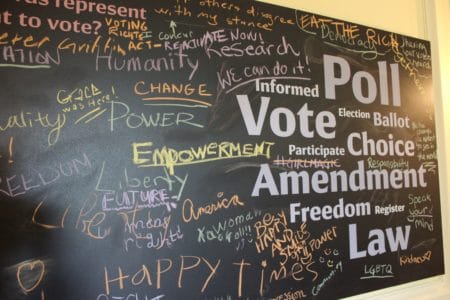Upstairs at the Swan House on the grounds of the Atlanta History Center are two rooms filled with dozens of historic artifacts, from documents to dresses to a judge’s robe and gavel. They all come together to contribute to the story of the women’s voting rights movement in Atlanta and Georgia and its impact on women in politics.
The artifacts are part of a new exhibit, “Any Great Change: The Centennial of the 19th Amendment,” commemorating the 100th anniversary of women gaining the right in 1920 to vote in elections. The exhibit about the advocacy for suffrage – a term for voting rights – remains open through Jan. 31, 2021.
“What we wanted to do was capture a full year of time … to show people that, over time, people have been fighting for their voting rights and to take down barriers to the voting booth,” said Jessica VanLanduyt, lead curator for the exhibition and the Atlanta History Center’s vice president of guest experiences.
“And hopefully in an election year [in 2020], people will be inspired to vote or be inspired to participate in some way,” she said.
The artifacts on display include dozens of political buttons, one from the 1963 March on Washington by Civil Rights activists; a vintage purple dress fitted with a gold-and-white sash that reads “Votes for Women”; and a banner hanging in a window inked with the portrait of Grace Towns Hamilton, who in 1965 became the first African American woman elected to the Georgia General Assembly.
In the center of one room stands a mannequin draped with a black robe that belonged to former Georgia Supreme Court Chief Justice Leah Ward Sears. Sears was the first African American woman to serve as a chief justice of a state supreme court.

Her successful election as chief justice is a direct link to the women’s suffrage movement, VanLanduyt said. The same thing can be said for all women elected to hold office, including the ones who last year made up the largest group of women elected Congress.
“This is still so present for us,” she said. “It has not happened in a far-away past.”
Lining the top of a wall in one of the rooms is a “Road to Suffrage” timeline. On one end is the year 1848, marking the first women’s rights convention, held in Seneca Falls, N.Y.; at the other end is the year 1920, when Tennessee became the 36th state to ratify the 19th Amendment to the U.S. Constitution, making it law and giving some women the right to vote. And just past that 1920 entry is the year 1970, when Georgia belatedly voted to ratify the 19th amendment.
VanLanduyt said the Swan House was specifically chosen to host this exhibit because two of Atlanta’s top women’s suffrage activists were Emily C. MacDougald and her daughter, Emily Inman, who built the house in 1928.
Inman is named on a yellowed piece of paper from 1915 that is labeled “Suffrage Parade Program” by the Equal Suffrage Party of Georgia. That was the first women’s suffrage parade in Atlanta and included floats from groups like the Fulton and DeKalb County Branch and the Atlanta Equal Suffrage League.
“She drove in Atlanta’s first suffrage parade … and her mother was a catalyst to the founding of the Equal Suffrage Party of Georgia,” VanLanduyt said.

The passage of the 19th amendment did not mean all women could cast ballots, however. Mostly, white women benefited. The law required women voters to be citizens, and different states had different definitions. African American women still could not vote, nor could Native American or Chinese women.
As the curator of the exhibit, VanLanduyt said she wanted to acknowledge this piece of history as well. Several women of color are highlighted for their activism in the women’s suffrage movement, even though they knew they would not benefit.
One such woman was Mary A. McCurdy, whose portrait is featured on a purple banner in the exhibit. She was an African American journalist who moved to Atlanta in 1886 and then to Rome, Ga., where she became editor of the “Woman’s World” newspaper.
In her 1895 essay “Duty of the State to the Negro,” McCurdy wrote, “Then we dare to insist upon the State doing its duty to the Negro [men], and in the meantime we forget not the thousands of women who are pleading to-day for equal franchise.”
Another was Dr. Mabel Lee, whose family moved to New York from China when she was 4. By the time she was 16, Lee was a well-known figure in the women’s suffrage movement. But she wasn’t able to vote until 1943 due to a federal law banning Chinese immigrants from becoming citizens.

“We really wanted to call out that all types of women participated, and whether they were going to get to exercise the right to vote is not any sort of barrier to participating in the movement,” VanLanduyt said.
Barriers to voting have existed since the country’s founding and continue today, VanLanduyt said. A goal of the exhibit is get people to not just think as voters but as citizens, to think about issues facing their communities and how to find solutions.
“We’re not just talking about voting, but also about community service, attending community meetings, just being informed, registering to vote,” she said.
And, yes, voter registration forms are available within the exhibit.
“When you have access to vote, you should use it,” VanLanduyt said.
The History Center is located at 130 West Paces Ferry Road in Buckhead. For more information, see atlantahistorycenter.com.

